Understanding the Risk: HIV and the Transgender Community

Introduction
HIV has been one of the most discriminated against and demonised conditions. With puritanical fanatics sinking their teeth into one out of four ways that the virus can spread, they've smeared its name and managed to spread misinformation about the infection to boot.
The National AIDS Control Organisation (NACO) has reported that transgender individuals have a significantly higher prevalence of HIV compared to the general population. The same minority community famous for its impeccable swag lacks access to healthcare resources. It would all be so tragically poetic if it wasn't clearly ordained to be this way.
Kofuku is here to make you, dear inquisitive reader, see the complex web of social, economic, and systemic factors that create this vulnerability. Get ready for a blog full of collisions between societal rejection and survival, where lack of legal protection meets the harsh realities of marginalisation. This isn't just a health issue; it's a human rights issue because it doesn't need to be reiterated that everyone deserves the chance to live a healthy, dignified life, regardless of their gender identity.
HIV: What It Is and How It Spreads
But first, a quick lesson on HIV to put all the misconceptions to sleep.
HIV (Human Immunodeficiency Virus) is a virus that attacks the body's immune system, making it harder to fight off infections. If left untreated, it can lead to AIDS (Acquired Immunodeficiency Syndrome).
Guess which one of these ways that HIV can be transmitted through that the fanatics judged heavily on :
-
Unprotected sexual intercourse.
-
Sharing needles or syringes.
-
Mother-to-child transmission during pregnancy, childbirth, or breastfeeding.
-
Blood transfusions (though this is rare in countries with strict screening).
And bingo! They, indeed, latch onto the first one hard, especially against the then infantile LGBTQ+ community.

HIV Risks
In direct contradiction to their raving rants, it is proven that HIV can affect anyone, regardless of sexual orientation or gender identity. However, certain factors increase the risk, including:
-
Unprotected sex.
-
Multiple sexual partners.
-
Injection drug use.
-
Lack of access to healthcare and education.
-
Social stigma and discrimination.
HIV and the LGBTQ+ Community
Most of the risk factors are caused by the discrimination faced by the community. The HIV/AIDS epidemic in the 1980s disproportionately affected the LGBTQ+ community, particularly gay men. This led to even more stigma and discrimination, which, unfortunately, continues to impact marginalised communities to this date.
The Complex Role of Prostitution and Transgender Vulnerability in India
A report by UNAIDS reveals that transgender women are 49 times more likely to be living with HIV than all adults of reproductive age, which brings us to one other main cause - ostracism. Many transgender individuals face severe economic and social marginalisation, often leading to sex work as a means of survival.
Societal stigma and discrimination often lead to family rejection, limited educational opportunities, and employment barriers. This displacement forces many into marginalised communities, where sex work becomes a matter of survival.
With no one in their corner, transgender sex workers often lack legal protections, making them vulnerable to exploitation, violence, and abuse. This lack of protection makes it difficult to negotiate safe sex practices or seek help when needed.
The minority nature of the community, caused by societal rejection, increases the risk of HIV transmission. How, you ask? When a community is small and marginalised, the risk of disease spread is increased due to the small, and often interconnected, social circles. Lesbians knowing each other's exes is hence a proven fact.
Resources for a Healthier Future
With all that hindering their way, it is no wonder they are part of the risk pool when it comes to HIV.
Despite all the challenges, though, there has been a growing number of organisations and resources working to support the transgender community in India.
-
NACO (National AIDS Control Organisation): NACO provides information, testing, and treatment services for HIV/AIDS.
-
The Humsafar Trust: This Mumbai-based organisation offers support, counselling, and healthcare services for the LGBTQ+ community, including transgender individuals.
-
SAATHII (Solidarity and Action Against The HIV Infection in India): SAATHII works to improve the health and well-being of marginalised communities, including transgender people, focusing specifically on HIV prevention and care.

Conclusion
The heightened risk of HIV within the transgender community in India is an issue that needs careful investigation and immediate action. By understanding the root causes, we can work towards creating a more inclusive and supportive society. It is important to remember that transgender people are not the cause of the increased HIV rates, but rather, they are a group that is more vulnerable to contracting the disease due to societal pressures.
By working together to dismantle misinformation and prejudice, we can build a future where everyone has the opportunity to live a healthy and fulfilling life.
Practice safe sex for a healthier tomorrow!
FAQs
Does hormone replacement therapy (HRT) directly increase the risk of HIV transmission?
Although HRT itself does not directly increase the risk of HIV transmission, some behaviours associated with accessing or administering HRT might indirectly increase risk. For example, sharing needles for injections could transmit HIV. If HRT leads to increased sexual activity without protection involved, this could increase the risk as well. Most of all, it's better to prioritise safe injection practices and safe sex regardless of whether or not a person is undergoing HRT or is infected with HIV.
How does mental health impact HIV risk in the transgender community?
Transgender individuals often experience higher rates of depression, anxiety, and PTSD due to discrimination and marginalisation. These mental health challenges can lead to risky behaviors, such as substance use or engaging in sex work for survival, which increase the risk of HIV. Mental health issues can also hinder individuals from seeking or adhering to HIV prevention and treatment services. Which is honestly so dangerous to both themselves and anyone they've come in contact with in a way that can spread HIV.
Are there specific challenges in accessing HIV testing and treatment for transgender individuals?
Of course, it is the same for general health care as well. Many transgender individuals have to jump through hoops to access proper healthcare, including HIV services. Either from the doctors and staff being transphobic or them lacking the understanding of transgender health needs. Many transgender individuals also face economic hardship, making it difficult to afford healthcare.
How does the lack of legal recognition of gender identity affect HIV risk?
The lack of legal recognition can exacerbate HIV risk. Without legal recognition, transgender individuals may face difficulties gaining essential services like healthcare and employment. This can lead to increased vulnerability to poverty, homelessness, and survival sex work, all of which increase HIV risk. Legal recognition is the first step in both eradicating the HIV risk factors AND ensuring equal rights and protections.
What are some effective HIV prevention strategies specifically tailored for the transgender community?
-
A culturally competent education. We're talking about accurate information about HIV prevention tailored to the specific needs of transgender individuals.
-
Easy access to prevention tools like condoms and lubricants is also a must.
-
Offering PrEP, a medication that can prevent HIV infection, to transgender individuals at high risk.
-
Providing services like needle exchange programs for those who inject drugs and tailoring rehab programs to fit their needs.
-
Addressing mental health needs to reduce risky behaviours.
-
Creating safe spaces and community networks that promote safe sex practices and provide emotional support.


Challenges In Transgender Mental Health: Navigating the LGBTQIA+ Realities in India

Affirming LGBTQ Healthcare in 2025 – Breaking Barriers

Understanding the Barriers to Mental Health Care in Minority Populations


